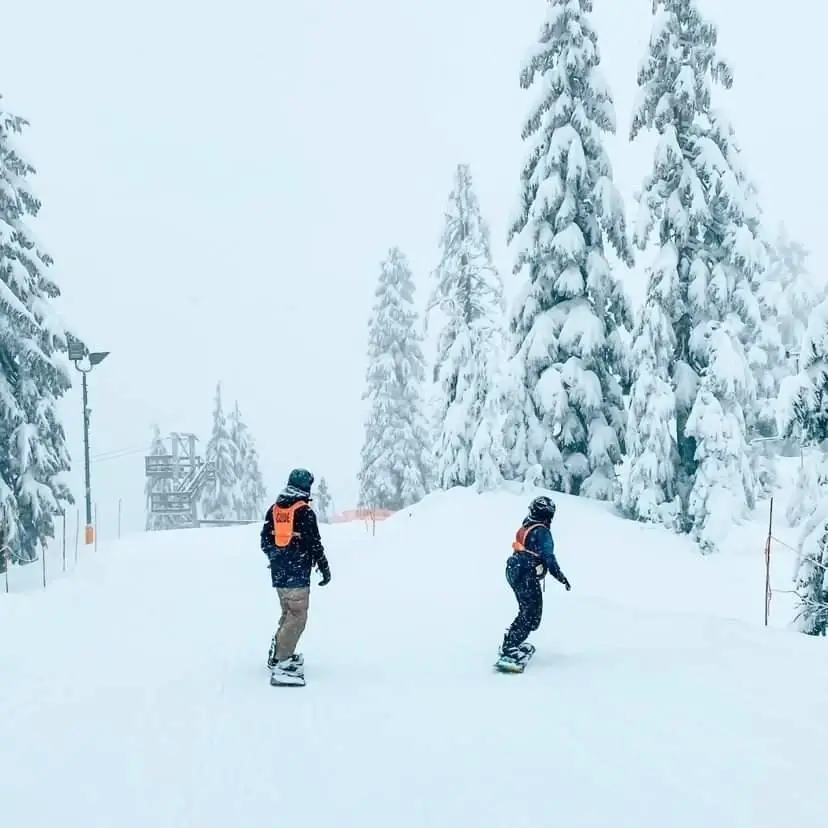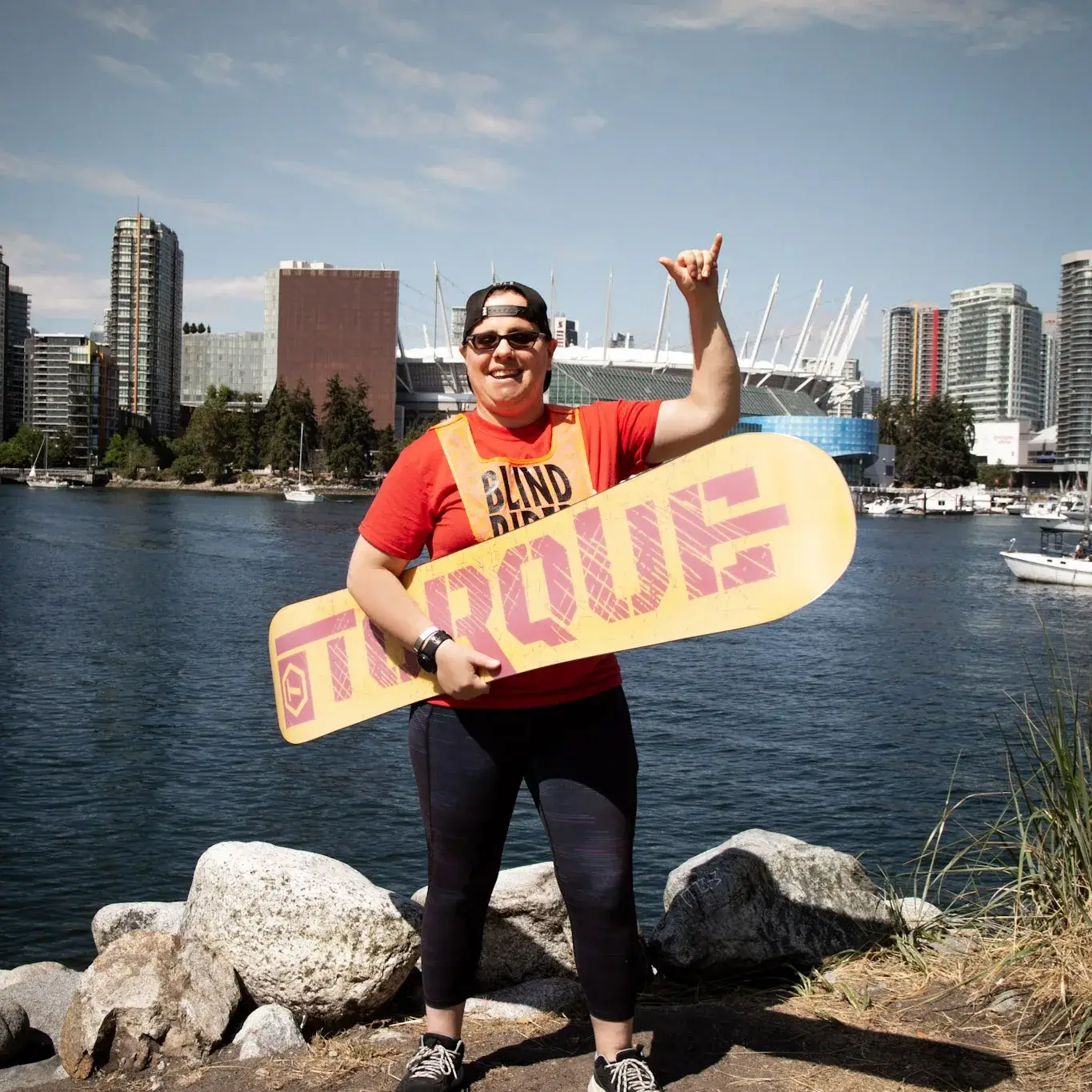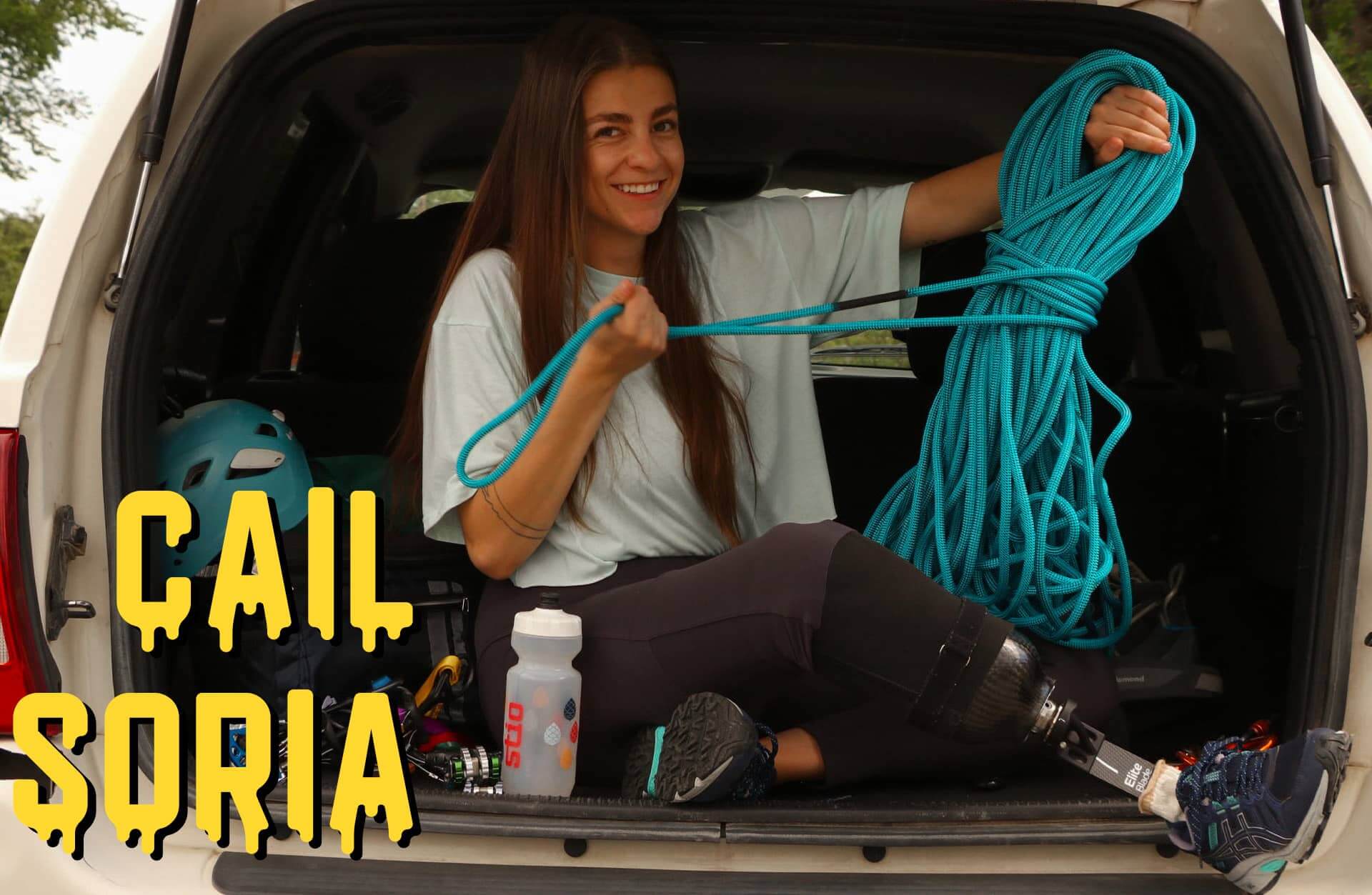SNOW // 01 SEP 2023
TEAM STARFISH
When thinking of sports teams, snowboarding is not the first activity that comes to mind. But for Team Starfish, every run down the mountain is a collaborative effort. “[The team] actually got its name on the mountain,” explained Emily Trepanier, a legally blind snowboarder. “When I first started snowboarding, my coach was trying to figure out how to explain how I would fall, because he said it was a unique way of falling. It took him a while to figure it out, but then one day we were snowboarding, and I ended up falling, and he yelled out, ‘Starfish!’ He’s like, ‘every time you fall, your hands go out and your legs go like a starfish. It doesn’t really matter what way you fall. Could be sideways, on your back, on your front. You always seem to end up in a starfish position.’ And I was like, I kind of like that name.”

Born in Ontario, Canada, Trepanier was always a rough and tumble kid. Whether it was playing outside with her siblings, or playing team sports at school, she looked for ways to be active. When invited by her best friend Linzy to check out their local adaptive snowsports program, Trepanier’s answer was an unsurprising ‘yes’. “ It’s called the Kitchener Track 3 Program, and it teaches people with disabilities to ski and snowboard,” she explained. “I actually started out in the skiing portion of the program, and I did that for a year or two.”
However, just as Trepanier was getting into the groove of skiing, an unexpected injury knocked her ski guide off the mountain for the season. Without a guide, Trepanier was unable to ski at all that season, but luckily Linzy’s guide had a solution. “It happened to work out well because Linzy had been learning how to snowboard, and she had two guides at the time. Her main guide was like, ‘well, do you want to learn how to snowboard since you can’t ski right now?’ I was like, sure, why not? I tried it out and I haven’t been back to skiing since,” she laughed.
From her first time on the snow, Trepanier knew she wanted to race. That competitive drive to go above and beyond has followed Trepanier since childhood as she explained, “I feel like I’ve always had that [motivation] because I don’t ever remember not having it. I feel like not being able to see very well [meant] I’ve always had to work harder to accomplish things. I know as a child, if I ever wanted to do sports at the public school I was going to, I’d tell my parents and they were like, ‘okay, we’ll figure out a way to make that happen’. Yeah, I feel like I’ve always had that [drive]. It definitely has grown since training as an athlete.”
Over eleven years of snowboarding and seven years of racing later, Trepanier goes down the slopes with the same joy she did on day one. Even when she has to face the occasional unexpected challenge. “There is one particular race that I went to in Ontario, in Mansfield. I was petrified of the start gate because we literally had to walk up a huge staircase to get to there,” recalled Trepanier. “The first time I walked up there, I was like, why are we walking upstairs to get to the start gate? And my guide’s like, ‘because the start gate is up the stairs and in a big shed. It might feel like a huge drop to you.’ I was super scared as soon as we got up the stairs. The first two times I tried I fell down the ramp because it was super steep and I was trying to figure it out. The third time I stuck the landing. Everyone around me, even though it was a practice run, they started cheering and yelling super loud.”
While Trepanier is of course the star of Team Starfish, there are many rays to this sea-star that help her safely get down the mountain, push progression, and enjoy her day to day life.
Whether she’s on the mountain, off the mountain, kayaking, swimming, SUPing, Trepanier is always accompanied by her guide dog Darling. Working together for the last five years, she is Trepanier’s ultimate adventure buddy.
For her dryland training, Trepanier works with coach Scott McGinley to build strength and proprioception. “[It’s a lot of] overall maintenance and general upkeep,” explained McGinley. “But we also work on the qualities that are going to assist her on the mountain. We definitely squat a lot given that snowboard stance.”

In preparation for the upcoming race season, the focus has been on combining stability with motion such that Trepanier can easily re-orient herself in a space. An excellent example is Trepainer’s recent training victory: a rotating sumo squat. The movement starts in a low squat position and then pivoting on the front foot, the athlete rotates 180 degrees. This then repeats with the new front foot. The goal is to pendulum back and forth across a room and back. Guaranteed to get the thighs burning. Trepanier faces the extra challenge of traveling in a straight line without any visual cues. It is difficult for the body to know exactly how much it has rotated. But with practice, Trepanier has mastered the motion, keeping her pivots on point.
As McGinley’s first visually impaired client, Trepanier has taught him just as much as he’s taught her. “It’s so important to be really precise with what you’re saying,” explained McGinely. “I think Emily is quite good at checking me when I say, take a big step back. No, it’s take a meter step back.”
He continued. “[At the beginning there were times I’d say], okay, I’ve got to be safe. I don’t know what her limits are. Then everytime I would have to just check myself because she flies down a mountain on a snowboard,” he laughed. “If she takes the odd tumble in the gym, it’s not the end of the world. She can pick herself up. She’s good.”
When it comes to her more specific race training, Trepanier is coached by Nicole Pringle, Mark Hopkins, and Darien Pringle. Focused on form, they give Trepanier pointers and feedback during her training to get her going down the slopes faster.
For her everyday resort cruising, Trepanier has a blocker, Zach Ormiston. “People are sometimes awesome and give [Emily] lots of space, and other times it’s just not the best. If we don’t have someone else, sometimes we’ll have a second snowboarder skier who we act as a blocker, almost like your linebacker,” explained the final member of the team, Trepanier’s snowboard guide, Isaac Zipursky.

Whether it’s a race day or powder day, Trepanier is accompanied by guide, coach, and friend Zipursky. While Trepanier does have some vision, the all white snow in combination with the speed makes it difficult for her to see objects clearly. As Trepanier puts it, “I have to trust Isaac because I can’t see on the mountain, he’s literally my eyes.”
Winding down the mountain together, Zipursky calls out “One. Three. One. Two,” cueing Trepanier when to turn. Being able to hear the turns along with seeing them, it is hard not to become mesmerized by the rhythm of Trepanier’s snowboarding. “When we get into a really good flow going down the mountain you get into a groove,” grinned Trepanier. “It definitely does feel like dancing down the snow.”
Zipursky and Trepanier began their partnership three years ago when she moved from Ontario to Vancouver for bigger mountains. The transition between guides is always a little tricky as Trepanier explained, “[Whenever I have] a new guide or new coaches, there’s a lot of emotions. Nervous, scared, wondering, are we going to mesh? Is he going to understand the way that I like to be guided? Is he going to be able to guide me so I understand how I’m going to be guided?” Zipursky elaborated, “Trust is one of the biggest aspects. Emily is obviously a trooper. She is more than willing to help guide me in guiding her, which has been fantastic. And, yeah, there’s been some trial and error. I have almost run her into things. Well,” he paused. “I have run her into something, but it wasn’t that bad.”
“I’ve almost fallen off cliffs, too!” piped in Trepanier smiling.
“Yes, almost fallen off cliffs too,” Zipursky chuckled. “But I would say the biggest learning curve took place within the first two weeks because it was just building a relationship. If you can build a relationship of trust and communication, you can practically do anything.”
As is the case for most visually impaired categories of competitive events, snowboard racers are accompanied by a single guide for the race. Along with having Zipursky at her side, Trepanier is given the option to inspect the course by going down the run a few times before the race. She explained, “[In previous seasons] we would make sure we got [to the mountain] super early, figure out where the race course was and ski down that mountain so I could get an idea of what the snow was like and what that particular run was like. If we got there the night before, they typically wouldn’t have the racecourse set up, but at the very least we would be able to learn the snow. Race day, we always got there at the very beginning of the morning.”
While each member of Team Starfish may fill a different role and push different parts of Trepanier’s progression as a racer, there is one point that everyone concurs on: she goes hard. Never missing her strength training homework and on the mountain as much as possible, her dedication is largely inherent. Because Trepanier doesn’t just want to be an adaptive snowboard racer, she wants to be the best adaptive snowboard racer. Her goal is to compete at the 2026 Winter Paralympics.
“As a child, I was usually outside playing with my sisters, brothers, and friends. But when it came time for the Olympics, especially the Winter Olympics, I was super glued to the TV,” she grinned. “I loved watching it and always thought it would be super cool to be one of those athletes who compete.”
While ski racing has been around since the inception of the Paralympics, snowboarding was not introduced until 2014. Still fresh to the global stage, the sport is in its growth period which explains Team Starfish’s largest hurdle. There is currently no visually impaired category in the Paralympics for snowboard racing.
Zipursky explained, “When we were doing initial research on the Paralympics and if there was going to be any visually impaired bank slalom, I remember staying up to like 03:00 A.M. because I couldn’t sleep and just was messaging our Canadian Paralympic Representatives on Facebook trying to get information. I don’t see [a visually impaired category] here, but how can we get it here? They said the biggest thing is exposure.”

“I think even our biggest goal, even if the Paralympics is something that is going to be difficult to get into just due to the fact it’s not there, is just bringing enough awareness to get that ball rolling and continuing to be a part of that process,” said Zipursky. “Obviously with Emily getting sponsored, that’s fantastic. Just for the exposure of the sport, I think that’s the biggest thing. We would love to go backcountry snowboarding with Arc’teryx and be able to showcase that there’s no limit to the sport.” Along with Arc’teryx, Torque Snowboards has been working with Trepanier over the last year to share the hard work and talent of Team Starfish.
By generating interest in visually impaired snowboarding, Team Starfish hopes to not only motivate the Paralympics to include the sport, they also want to create a clearer path for other visually impaired athletes to pursue an interest in snowboard racing. “When I first started snowboarding and getting into racing, I had a really hard time finding the information and resources necessary to get into it,” explained Trepanier. “It was all scattered everywhere. It took a long time for me to find it and piece it together.”
Building community and sharing information is key to the growth of the sport, and Team Starfish encourages any athlete interested and looking for help to reach out to Trepanier. For the absolute beginner, Trepanier suggests contacting “a local mountain because most of the mountains will have lessons and they’ll also have programs for adaptive snowboarders. A lot of the mountains are getting that now. The programs are different all across the world, but I know the one here that’s a big one for adaptive snow sports is CADS, Canadian Adaptive Snowsports. Reach out to your local hill and ask them what programs are available. That’s literally how I got started.”
For those outside the adaptive community interested in supporting adaptive athletes, Zipursky encourages giving guiding a try. “Emily almost wasn’t able to go to her winter race camp this season because I wasn’t able to go and they almost couldn’t find a guide,” he explained. “I think [guiding is] such a great opportunity to come alongside any snowboarder who wants to try this out and give them opportunities. Just get out there and try [guiding] because ultimately Emily is the person trying everything with the most reasons not to try it.”

Even with Olympic goals in the back of her mind, Trepanier never forgets to just enjoy her days on the mountain and celebrate every victory. One huge win from the past season is her ability to recognize changing terrain by feel. Being able to comfortably transition between those icy spots, soft powder, and even mashed potato snow at the bottom of the mountain on a warm day makes guiding a little less wordy and cruising a whole lot more fun. “It was a suggestion at one of the race camps by one of the high performance coaches, to start to feel out the terrain, figure out what the terrain is like and adapt to it if possible. Because they said as you do more snowboarding and get more comfortable, [and thus faster], when something comes up it’s very sudden,” she explained. “It was definitely very nerve wracking at the beginning because I wasn’t getting all the information I wanted from feeling. [But now,] it’s not nearly as challenging as it used to be. I’ve gotten more and more comfortable each time on various terrains. It’s really neat.”





